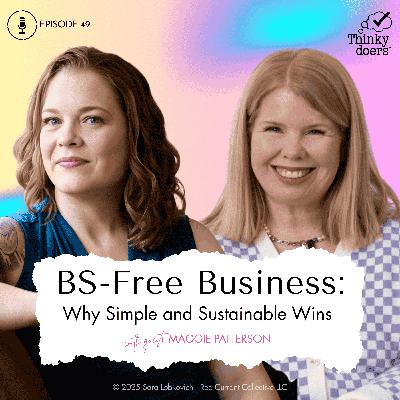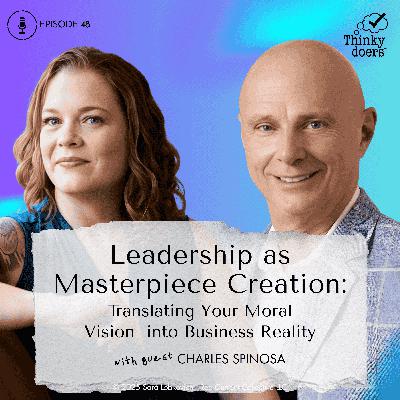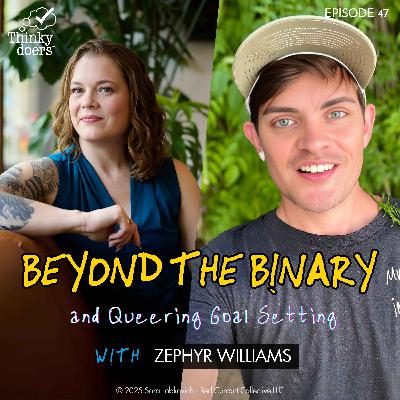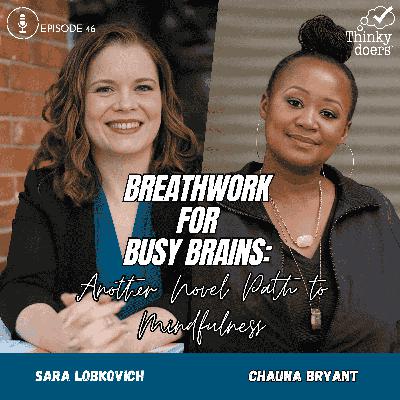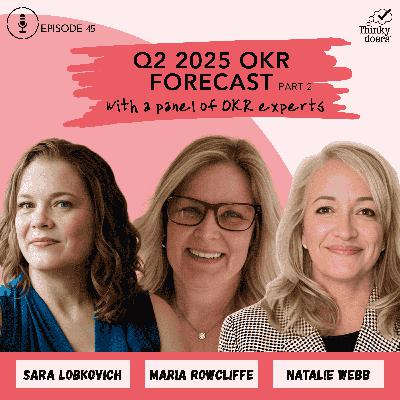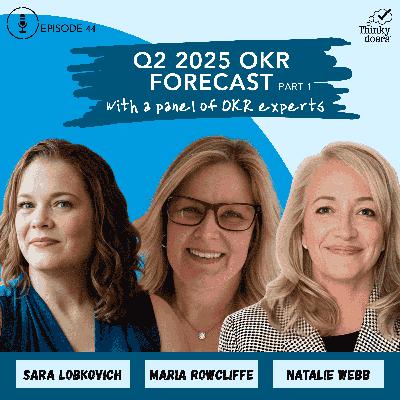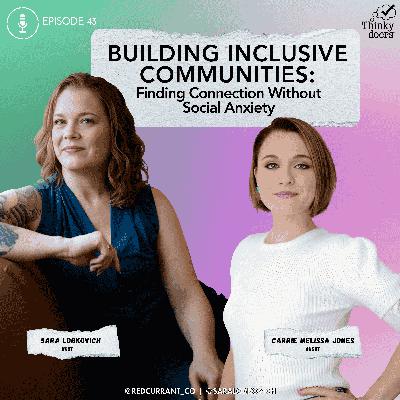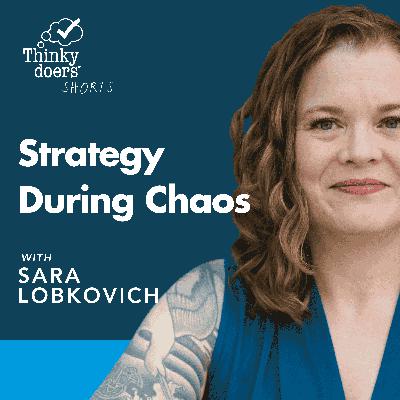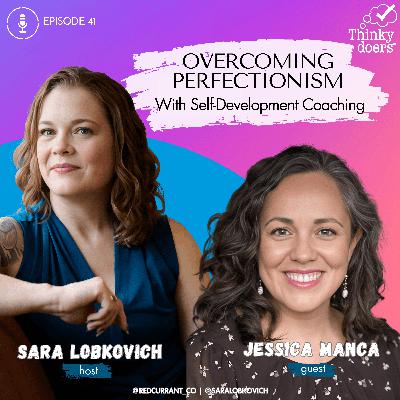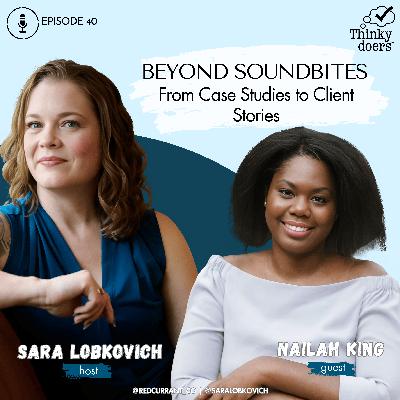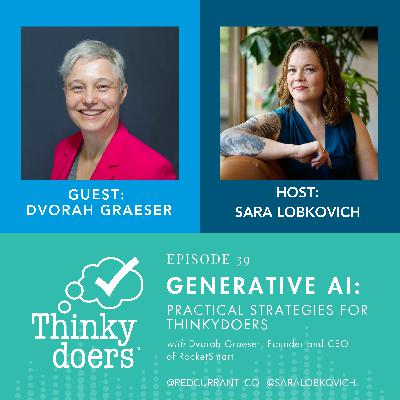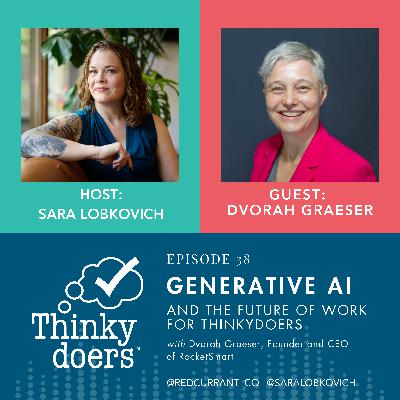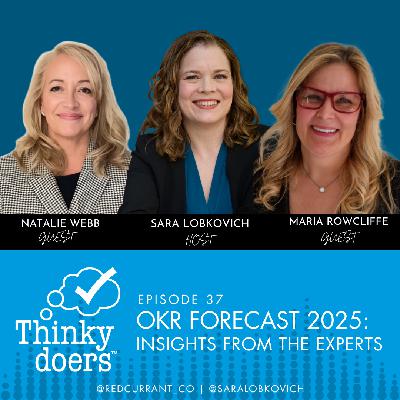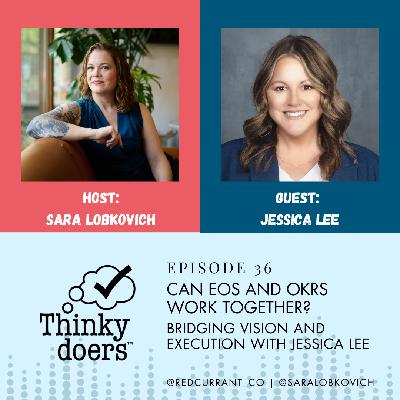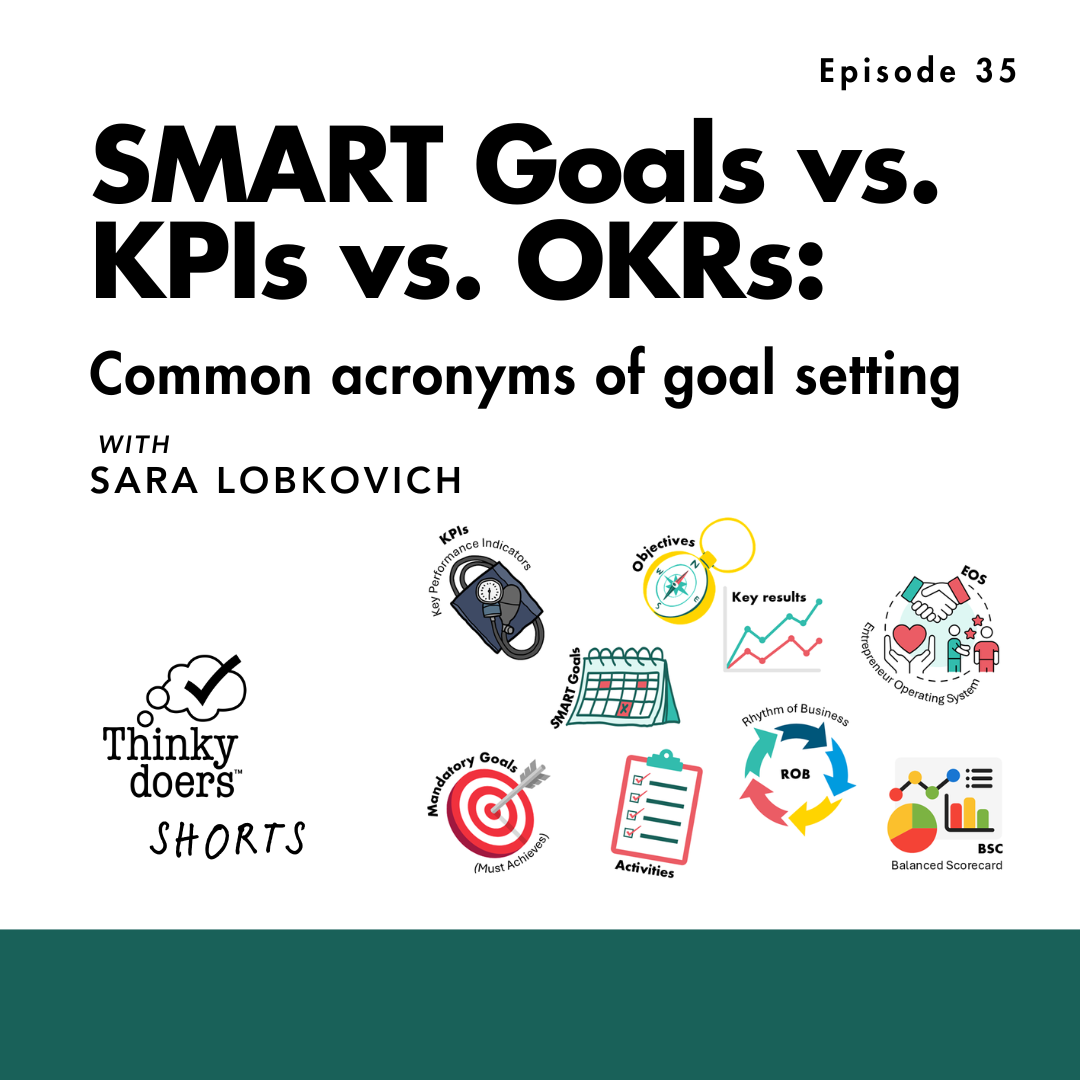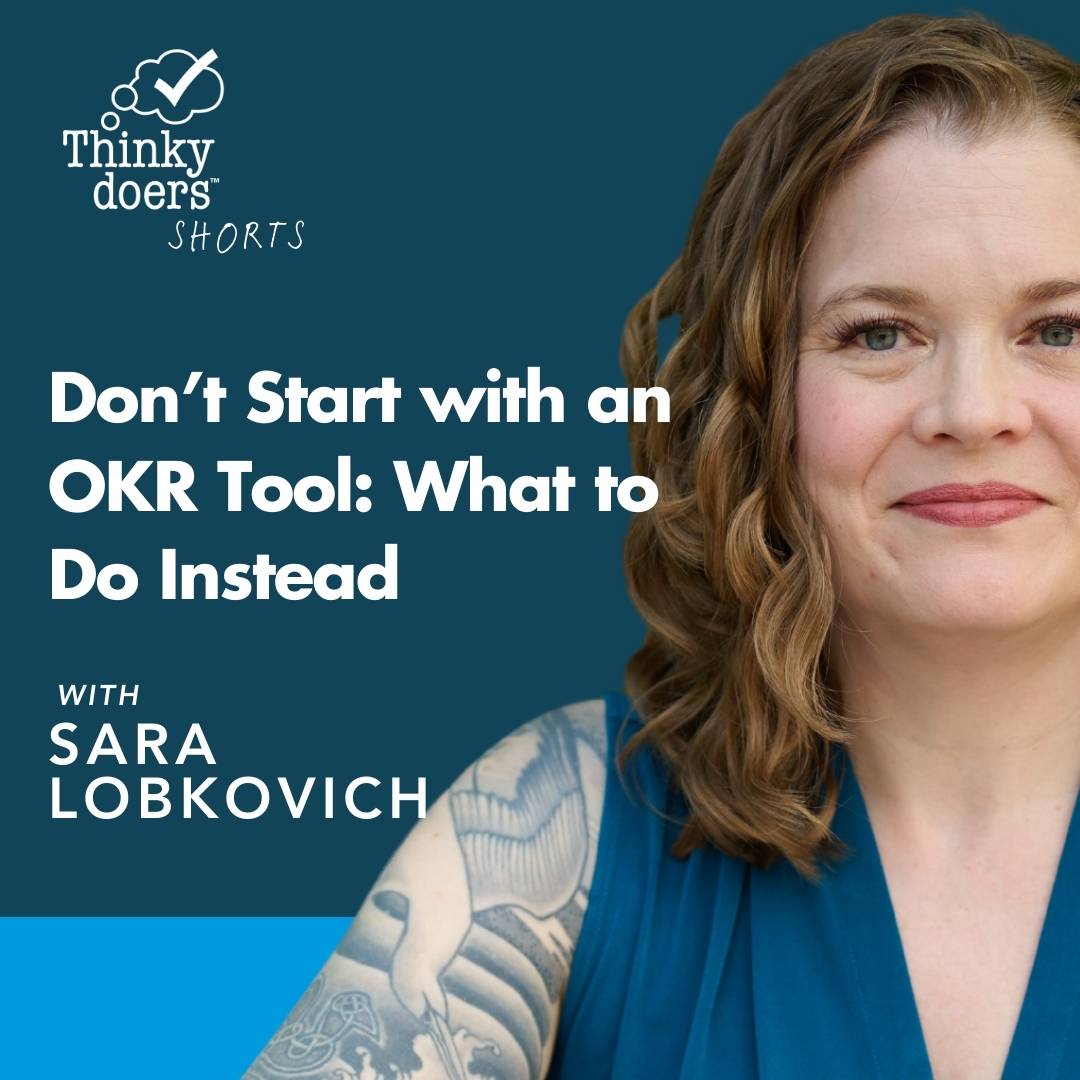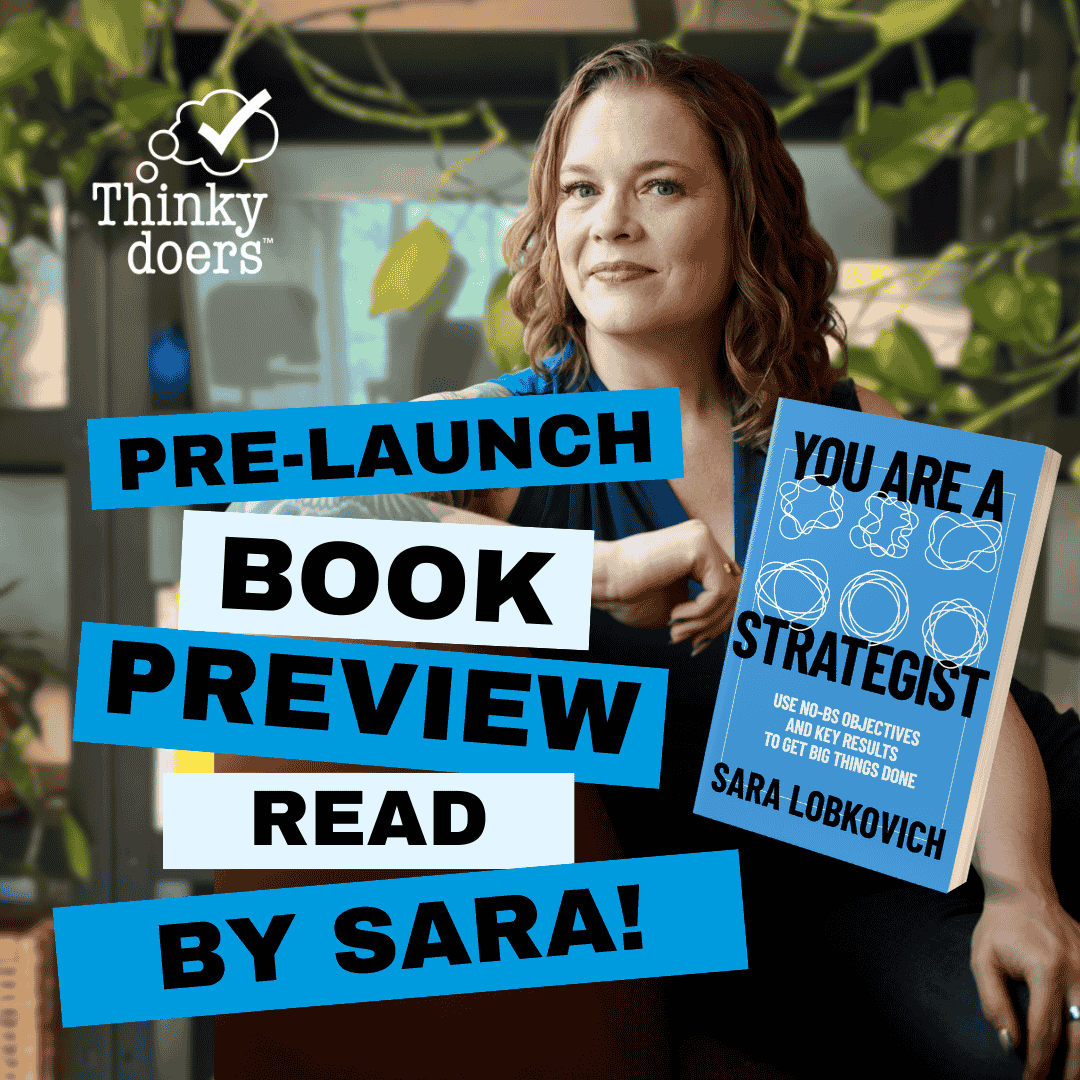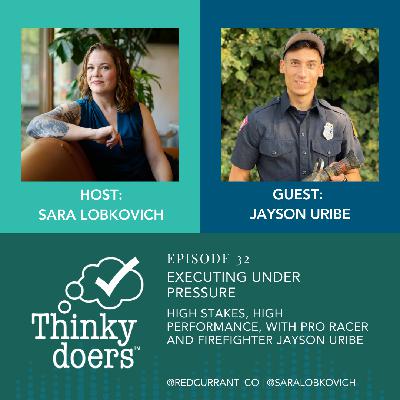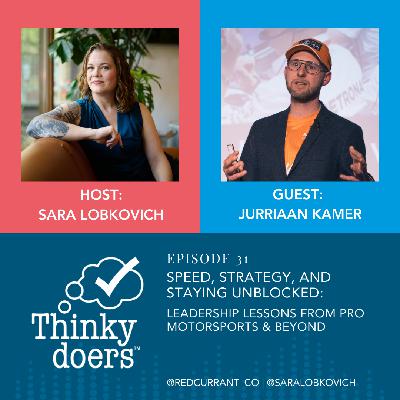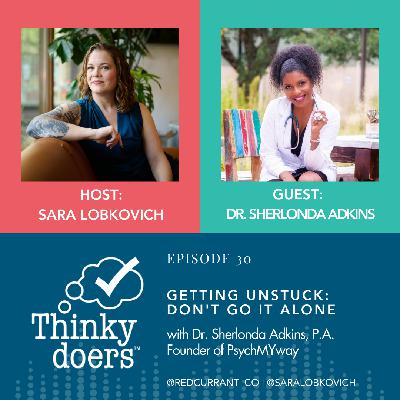Discover Thinkydoers®
Thinkydoers®

Thinkydoers®
Author: Sara Lobkovich
Subscribed: 4Played: 23Subscribe
Share
© Copyright 2019-2025, Sara Lobkovich
Description
Thinkydoers®, hosted by Strategy Rebel and OKR Coach Sara Lobkovich, is a community for unconventional leaders, status-quo challengers, and workplace “square pegs.” Thinkydoers are individuals who navigate the journey from insight to idea, through the messy middle, seeking courage and confidence to bring their visions to life.
Thinkydoers are a diverse group. We're disproportionately (but not exclusively) introverted and/or neurodivergent, and regardless of personality or cognitive wiring, Thinkydoers are strategic thinkers often underserved and misunderstood in traditional business cultures. Whether you’re a leader, an aspiring leader, or a behind-the-scenes “clutch player,” Thinkydoers aims to help you find more satisfaction, less frustration, and greater flow in your work.
Learn to unlock your inner strategist with No-BS OKRs. Then, explore topics way beyond goal-setting, including strategy, behavior change, cognitive health, and motivation. Our guest episodes feature a wide range of perspectives to support you in building the work/life you want most.
Increase your impact, reduce overwhelm, avoid burnout, and make the unique impacts only you can bring to the world. Here, you’ll discover how to build and maintain a fulfilling career and lead transformative efforts with significant outcomes, all while putting human outcomes first.
Thinkydoers are a diverse group. We're disproportionately (but not exclusively) introverted and/or neurodivergent, and regardless of personality or cognitive wiring, Thinkydoers are strategic thinkers often underserved and misunderstood in traditional business cultures. Whether you’re a leader, an aspiring leader, or a behind-the-scenes “clutch player,” Thinkydoers aims to help you find more satisfaction, less frustration, and greater flow in your work.
Learn to unlock your inner strategist with No-BS OKRs. Then, explore topics way beyond goal-setting, including strategy, behavior change, cognitive health, and motivation. Our guest episodes feature a wide range of perspectives to support you in building the work/life you want most.
Increase your impact, reduce overwhelm, avoid burnout, and make the unique impacts only you can bring to the world. Here, you’ll discover how to build and maintain a fulfilling career and lead transformative efforts with significant outcomes, all while putting human outcomes first.
50 Episodes
Reverse
Tired of building your business or career for the "fantasy version" of yourself?You're not alone. Many of us leave corporate environments that don't fit our neurodivergent, introverted, or strategically-wired brains, only to recreate the same extractive patterns in our own businesses. But what if there was another way?In this episode, I sit down with Maggie Patterson, creator of BS-Free Business and author of "Staying Solo," to explore why so much business advice isn't designed for businesses like yours. We dive into Maggie's "real-life rule" — if it doesn't work for your real life (with all your caregiving responsibilities, mental health considerations, and actual capacity constraints), it doesn't work in your business.Discover why being strategically wired can be a detriment as an employee but an asset as a solo business owner, learn how to build around your actual capacity instead of your maximum capacity, and find out why the best work you'll do might just be the work that feels easy.Episode Highlights:Why so much small business advice recreates the same toxic patterns we tried to leave behind in corporate lifeHow manipulative marketing tactics—like income claims and pain-point selling—harm solo business ownersWhy neurodivergent and introverted people often thrive as entrepreneurs after struggling in traditional workplacesThe “real-life rule”: building your business around actual capacity, not fantasy capacityHow being strategically wired can feel like a liability in corporate life but becomes a superpower in solo businessWhy the most sustainable businesses are often the simplest—lean, drama-free, and built to lastKey Concepts Explored:The "real-life rule": building business around actual capacity and constraints rather than fantasy versions of ourselvesThe neurodivergent advantage in solo business: creating accommodations for yourself that corporate environments can't provideStrategic brain blindness: how strategically-wired people undervalue their most marketable assetsThe employee detriment of strategic thinking: why strategic minds struggle in corporate but thrive as entrepreneursThe paradox of easy work: why the highest-value, most enjoyable work should feel effortless when you're truly skilledIncome claim marketing and pain point manipulation vs. empathetic connection in business communicationLesser of evils decision-making: sustainable business choices for people with anxiety, ADHD, and mental health challengesSimplicity as competitive advantage: lean operations, minimal services, and building incrementally rather than perfectlyRight-sizing dreams and expectations to prevent business-induced breakdown during caregiving and life challengesNeurodivergent entrepreneurship as affirmation: self-employment as refuge for those who don't fit traditional work cultureCommon Questions Answered:How can I build a business that works with my ADHD/anxiety/neurodivergence?Why do I struggle with traditional business advice?Is self-employment viable for introverts and strategic thinkers?How do I build for my real capacity instead of my maximum capacity?Why does my strategic thinking feel undervalued in corporate environments?Notable Quotes: "So much of online business is built on this fantasy version of yourself—someone with endless time, endless energy, endless capacity. And it just doesn’t exist." – Maggie Patterson [00:05:00]"We left corporate because it didn’t fit—but then we build businesses that are just as extractive, just as harmful, just as unsustainable." – Maggie Patterson [00:07:00]"If it doesn’t work in your real life—with your caregiving, your...
What if the critics and naysayers aren't a problem—but proof you're finally changing something that matters?Charles Spinosa spent decades as both a Shakespeare professor and management consultant, giving him a unique lens on what separates true leadership from good management. His approach isn't about influence or operational excellence—it's about moral artistry. It’s about the courage to ask "what always goes wrong?" and then take the risks necessary to create something beautiful instead.If you've ever felt like the person pointing out what's broken, if you have strong convictions about what's right even when it's unpopular, or if you're tired of managing around problems instead of solving them, this conversation will resonate deeply. Charles reveals why justice-sensitive and neurodivergent people often have a natural advantage in seeing what others miss—and how to turn that insight into transformational leadership. This episode will help you with leading leaders, and with seeing your own leadership development and career as a journey in masterpiece leadership.Episode Highlights:The two questions that define “masterpiece leadership:” What always goes wrong in your industry, and what would you love to do instead?How to distinguish between dissenters (who sharpen your vision) and betrayers (who undermine it).Why naysayers are often a sign that you’re taking the right kinds of risks.The neurodivergent advantage: spotting injustices and anomalies others overlook.Practical strategies for pushing through despair when moral risks don’t pay off right away.Justice sensitivity as a leadership strength—and how it positions you to create businesses worth falling in love with.Key Concepts Explored:Passion as a defining force that fuels resilience and long-term transformationThe Two-Question Framework that separates masterpiece creators from managersMoral risk-taking: why changing norms will always feel “wrong” at firstBetrayers vs. dissenters—and why dissent is essential for progressTruth-seeking platforms that go beyond psychological safety to real intellectual conflictPost-truth business culture and the limits of data without human truthJustice sensitivity as a leadership advantage for transformational changeThe neurodivergent edge in spotting anomalies and injustices others missMoral artistry: making solutions not just right, but beautifulFighting through despair and returning to core beliefs during setbacksAwe and wonder as signals you’re on the right pathA systemic change strategy for moving from easy wins to bold transformationsCommon Questions Answered:How can you take moral risks without putting your career in jeopardy?What separates managers from masterpiece creators?How should leaders handle team resistance to moral change?Notable Quotes: "What do people say leadership is these days? They say leadership is influence. I'm saying no. Leadership is taking moral risks to establish morally distinctive masterpieces. So I'm overturning a lot of norms. Of course there are gonna people who hate that." – Charles Spinosa [00:34:19]"So if I'm not hearing from naysayers, I might not be taking as much risk as I think I am, or as much risk as I could in pursuing a defining passion. That hearing from critics and naysayers says you're doing something different enough for people to have naysaying to do about it." – Sara Lobkovich [00:33:18]"Always be sensitive to what's going wrong in your organization. And don't forget to ask what you would love instead. And try to make the solutions you offer beautiful." – Charles Spinosa [00:32:57]"So if you're a leader,...
What if everything you've been taught about goal setting is actually working against you?What if the rigid structure of SMART goals is crushing your creativity, disconnecting you from your body, and forcing you into a binary that simply doesn't fit who you are?Today's guest, Zephyr (Zeph) Williams (they/them), is an anti-hustle business strategist who helps radical entrepreneurs build "breathe-easy businesses." When Zeph and I connected over our mutual loathing of SMART goals on social media, I knew we had to have this conversation.In this episode, we're diving deep into why traditional goal-setting methods fail so many of us—especially neurodivergent folks and anyone who doesn't fit the conventional mold. Zeph introduces their revolutionary SLIC method (Sustainable, Long-term, Iterative, Consistent) and shares why self-care isn't optional—it's strategic. But the real magic happens when we land on a beautiful reframe that might just change how you think about achievement forever.Want to see how No-BS OKRs fit into a coherent Connected Strategic Stack?This No-BS Connected Strategy Guide shows you what “good” looks like. Download examples of finished Connected Strategic Stacks — including best practice No-BS OKRs — and get instant clarity on your next strategic step. Includes a quick self-assessment to pinpoint your organization’s biggest OKR opportunities.GET THE GUIDEEpisode Highlights:Why SMART goals create a restrictive binary that crushes creativity and explorationThe semantic problems with SMART goal terminology that create confusion and ambiguityHow "specific" goals create tunnel vision that blocks curiosity and the learning journeyThe SLIC Method: Sustainable, Long-term, Iterative, and Consistent goal-settingWhy self-care isn't selfish—it's a strategic foundation for sustainable successHow to reconnect with your body through micro-practices and energy trackingThe role of grace and compassion when breaking free from binary thinkingWhat "queering" business practices means and why it's for everyoneThe beautiful reframe from "goal setting" to "becoming"—asking "What am I becoming?"Why consistency means showing up as your needs allow, not the same way every dayHow traditional goal-setting often leads to self-abandonment and disconnection from the bodyKey Concepts Explored:The binary nature of SMART goals and why they create a restrictive pass/fail mentalityThe SLIC Method as an alternative: Sustainable, Long-term, Iterative, and Consistent goal-settingSelf-care as a radical act of rebellion against systems that devalue your worth"Queering" business practices to move beyond traditional binary frameworksThe shift from "goal setting" to "becoming" as a more expansive approach to growthBody-based awareness and reconnecting with somatic needs during goal pursuitWhy consistency means showing up according to your capacity, not rigid daily habitsCommon Questions Answered:Why do SMART goals feel so restrictive and overwhelming?What makes the SLIC method different from traditional goal-setting?How do you start reconnecting with your body if you feel disconnected?What does "queering" goal setting actually mean?How do you define consistency without burning out?Why is self-care considered strategic rather than selfish?Notable Quotes: "SMART goals are very binary. You either succeed or you fail. And I'm not somebody who does the binary very well." - Zeph Williams [00:03:00]"When I hear 'specific,' it feels like a narrowing down... You don't get to enjoy the journey and enjoying the...
Ever feel like your brain just won’t quit, and traditional meditation only makes it worse? Thinkydoers host Sara Lobkovich gets it. She lives mostly in her head, and practices like meditation or breathwork have often felt out of reach. They seemed like they were designed for people who are naturally calm and centered — not her.But this conversation with Chauna Bryant shifted everything. Chauna is a trauma-informed breathwork professional, and founder of Breath Liberation Society. She also describes herself as “probably the least chill meditation teacher you’ll ever meet.”Together, they explore how breathwork can offer a more accessible entry point for overthinkers and busy brains. Instead of forcing stillness, breathwork gives the mind something active to focus on — what Chauna compares to “giving your brain an iPad” to occupy it — while the body does its own work.They also talk about how breathwork differs from traditional meditation, why it’s particularly helpful for people with trauma histories, and how starting small (even just two breaths or two minutes) can be helpful.If mindfulness has ever felt like it wasn’t made for your kind of mind, this episode is for you.Episode Highlights:Why breathwork succeeds where traditional meditation fails for many peopleThe difference between activating and calming breathwork techniquesHow to start a somatic practice when you're resistant to body-based workTrauma-informed approaches to breathwork and nervous system regulationThe power of "titration" - starting with just 2 minutes instead of diving inWhy consent and agency are crucial in breathwork practiceUnderstanding breathwork as "nervous system pushups" for stress resilienceKey Concepts Explored:Conscious connected breathing and three-part breath techniquesThe origins and cultural lineages of breathwork practicesHow breathwork allows nonverbal processing of emotions and traumaThe importance of finding trauma-informed, skilled practitionersWhy patience becomes "your first form of body connection"Common Questions Answered:What exactly is breathwork and how is it different from meditation?How can I start if I'm resistant to body-based practices?Is breathwork safe for people with trauma history?What should I expect from my first breathwork experience?Notable Quotes: “Breathwork gives the brain something to do. It’s just weird enough that it helps the body start to process what we’ve shelved or ignored.” — Chauna Bryant [00:04:00]“Whatever you’re doing, try like a minute. Try two minutes. Give it two minutes and then get out. That’s the way to start to build that body connection.” — Chauna Bryant [00:14:00]“For a lot of us with busy brains, patience is going to be our first form of body connection.” — Chauna Bryant [00:16:00]“Just let the experience exist without having to slap words on it.” — Chauna Bryant [00:31:00]“In breathwork, you get to choose as much or as little as you do—and whatever you choose, you’ll be cheered on fiercely.” — Chauna Bryant [00:34:00]Chapters:[00:00:00] Introduction: Welcome to Thinkydoers and Meet Chauna Bryant[00:02:00] What is Breathwork? Active Meditation for Busy Brains[00:05:00] Origins and Cultural Lineages of Breathwork Practices[00:06:00] From Brain-Centered to Body-Aware: Sara and Chauna's Common Ground[00:08:00] Chauna's Journey: From Gymnast to "Least Chill Meditation Teacher"[00:11:00] The Meditation Failure and Discovering Breathwork[00:12:00] Getting Started: Overcoming Resistance to Somatic Practices[00:15:00] Perfectionism and All-or-Nothing Thinking in Body
The OKR Trio is back with Part 2 of their brutally honest Q2 2025 forecast, and they're not holding back. Sara Lobkovich, Maria Rowcliffe, and Natalie Webb tackle the questions you've been asking about rigid vs. flexible OKR approaches, timing models that actually work, and trends we’re seeing in tool choices.But here's where it gets spicy: they're sharing their most controversial OKR opinions, speed round style! From leaders trying to weaponize OKRs as surveillance tools to the popular (but problematic) advice to limit teams to just one strategic priority, this conversation will challenge norms you might not be able to imagine actually exist out there.You'll discover why monthly check-ins might mean you're tracking instead of managing, how geography is shaping OKR strategy differently across continents, and why Excel is making a surprising comeback in the enterprise. Plus, Sara drops a financial metrics hot take that might make your CFO squirm.This isn't your typical goal-setting advice. It's three veteran practitioners sharing what they're really seeing in the field, complete with the controversies, contradictions, and hard-won insights that only come from years in the trenches.Episode Highlights:Quarterly vs. Trimesterly Planning: why the Q4 “drop-off” is real—and how cadence choices impact OKR adoption across teamsBiweekly Reinforcement Loops: how one leadership team’s consistent review rhythm is accelerating organization-wide buy-inTool Sprawl & Excel Resurgence: why many orgs are ditching premium OKR platforms for scrappier, process-first setupsWhen Tools Hurt More Than Help: the danger of letting project management tools define your key resultsHot Takes on OKRs: financial metrics don’t belong in key results (and one-size-fits-all “just one OKR” advice? Hard pass)Big Brother OKRs?: pushing back when leadership wants to use OKRs for surveillance instead of strategyQ3 Preview: a deep dive on execution, achievement—and how to actually decide what OKR tooling makes sense for your orgKey Concepts Explored:Hybrid Localization ApproachesLeadership sets objectives, teams shape Key ResultsThemes as bridges when objectives don't translate locallyKRs and Sub-KRs for fast-moving Scrum teamsMoving away from rigid objective cascadingTiming Model EvolutionBiweekly check-ins integrated with Scrum cyclesThe discipline of at least twice-weekly KR managementQuarterly vs. trimester cycle trade-offsEvent-triggered OKR adjustments for volatile environmentsTool Integration StrategiesProcess-first, tool-second implementation approachExcel resurgence due to cost considerationsAvoiding dueling OKR and project management platformsRecognition that L1 and L2 math doesn't require specialty softwareControversial Practices and Hot TakesOKRs as surveillance tools (problematic)Arbitrary "one OKR only" mandates (counterproductive)Financial metrics as KPIs vs. Key Results (contentious)Project deliverables masquerading as OKRs (misleading)Notable Quotes: "If you have a KR that you only manage monthly, you are not managing it, you're tracking it. Because you essentially have two data points, and then the quarter is over." — Maria Rowcliffe [00:06:00]"Once we learn the words and leadership is modeling the words and meanings, then the rigidity can come out of the framework." — Sara Lobkovich [00:04:00]"Financial metrics belong in mandatories and budgets. They're KPIs, they aren't key results." — Sara Lobkovich [00:15:00]"Bad news only gets worse with time. So the earlier they can
Ever wonder what's really happening in the OKR world beyond the hype?Join Sara Lobkovich, Maria Rowcliffe, and Natalie Webb for a candid, no-BS look at where OKRs are heading in 2025. This isn't your typical "here's how to write an objective" conversation. Instead, you'll get insider insights from three veteran practitioners who've been in the trenches, helping organizations navigate the messy reality of goal-setting and alignment at scale.In this first part of our quarterly update, we dive deep into the generative AI revolution (spoiler: it's not as revolutionary as everyone claims), the evolving art of OKR localization across complex organizations, and why your retrospectives might be the most important OKR practice you might be doing wrong. Whether you're an OKR skeptic, a seasoned practitioner, or somewhere in between, this conversation will give you practical insights you can't get anywhere else.Episode Highlights:Generative AI in OKRs: why draft quality is improving, but real strategic impact is still lagging behindTRV (Technology Realized Value): the Big Five’s new metric for linking OKRs to actual tech investment outcomesThe “Two Lists” Problem: how teams are secretly working off dual strategies—and why it’s undermining OKR focusCascading and Localization: evolving models for aligning across global teams, even amid geopolitical complexityCulture-First OKRs: tailoring implementation to readiness, from transformation-driven overhauls to scrappy gradual rolloutsRetrospectives that matter: how deeper reflection—not just review—builds quarter-over-quarter OKR maturityKey Concepts Explored:Generative AI in OKRs: Where it's accelerating strategy work, where it's falling short, and the risk of generic, uncontextualized modelsTechnology Realized Value (TRV): A new metric used alongside OKRs to measure the tangible impact of tech investmentsThe “Two Lists” Problem: How parallel strategic workstreams outside the OKR framework dilute focus and undermine accountabilityLocalization & Alignment: Why clear, bottom-up contribution is critical in global, matrixed organizations—especially in high-stakes geopolitical climatesCulture-Responsive Implementation: Tailoring OKR rollouts based on organizational readiness, risk appetite, and transformation goalsIterative Learning over Perfection: Why OKR maturity builds quarter over quarter—and how learning from retrospectives is more valuable than writing the “perfect” OKRLeading vs. Lagging Indicators: The power of AI to help surface potential leading indicators clients may struggle to define on their ownTransformation & Change Management: How OKRs, when paired with transformation strategy, become powerful drivers of organizational evolutionNotable Quotes: "Is this really driving the value you wanted to achieve? How do you know who cares? So what happens if this is done or not done? These things that don't get asked are so critically important to make sure that people are focused on the right work." — Natalie Webb [00:12:00]"If I could only tell clients one thing about OKRs, it would be we spend all of our time focused on writing them and then way too little time focused on learning from them." — Sara Lobkovich [00:23:00]"I think the best way to use OKRs initially is always the way that the company is willing and able to adopt it. Me talking about the gold star way of doing OKRs isn't gonna help clients that are at the crawling level and not a hundred percent convinced yet." — Maria Rowcliffe [00:21:00]"OKRs are really hard. We're talking about change - really hard for people to stick with when it gets challenging." — Sara Lobkovich [00:28:00]Chapters:[00:00:00] Introduction:...
In a world that celebrates the loudest voices and the biggest followings, what if quiet spaces are where real belonging begins?In this deeply personal and connected conversation, Sara Lobkovich sits down with community strategist Carrie Melissa Jones to explore the surprising power of “quiet communities” — where introverts, neurodivergent folks, and the socially anxious can finally feel seen, heard, and safe.If you’ve ever felt like community just isn’t for you… this episode might just change everything.Episode Highlights:Carrie’s journey with social anxiety and building inclusive, "quiet" communitiesBelonging without active participation—research and real-life insightsUsing bodily awareness and boundaries to stay grounded as a community creatorSelf-leadership and support systems to prevent burnout in community workPractical tips for both hosts and participants to feel more confident and alignedKey Concepts Explored:Self-Regulation in Online Spaces: How digital communities offer spaces for thoughtful connection for introverts and neurodivergent people.Quiet Communities: Community spaces that don't demand constant engagement and allow people to participate on their own terms.Meaningful Engagement vs. Engagement for Engagement's Sake: The importance of connecting community activities to purpose and growth rather than arbitrary metrics.Body Awareness as Community Evaluation: Using physical reactions and feelings as guidance for whether a community is a good fit.Belonging Without Participation: Research findings on how affiliation alone can create a sense of belonging without requiring active involvement.Self-Leadership in Community Building: Managing internal dialogues and anxieties that arise when creating and managing communities.Community as Healing Practice: How creating spaces for others can help heal our own relationship to connection.Distributed Leadership: Inviting others' contributions rather than trying to do everything yourself.Community Building as a Long Game: The importance of patience and persistence in both building and participating in communities.Notable Quotes: "If there's a place that you wish existed... why not be the person that starts that?"— Carrie Melissa Jones [00:13:00] "You cannot do it alone. It's not a solo activity. To really create a community, you've got to see, recognize, and invite in the gifts of others and others' contributions."— Carrie Melissa Jones[00:42:32] - [00:42:54]I start everything I do scared and then once you get rolling it gets fun. Nothing starts fun. Everything starts with anxiety.— Sara Lobkovich [00:46:45]Chapters:[00:00:00] Introduction and Meet Carrie Melissa Jones[00:05:51] Social Anxiety and Career: Turning Challenges into Expertise[00:11:22] Redefining Community: "Quiet Communities" and Meaningful Engagement[00:15:38] Challenging the "Not a Joiner" Identity and Finding Your Fit[00:19:53] Body Awareness: Using Physical Responses as Your Community Guide[00:25:32] Advice for Shy Community Creators: Boundaries and Sustainability[00:29:42] Research Insights: Belonging Without Active Participation[00:39:03] Self-Leadership and Distributed Responsibility in Community Building[00:44:30] Practical Pre-Launch Strategies and "Doing It Scared"[00:48:10] The Long Game: Advice for Participants, Hosts, and Closing ThoughtsUpcoming Events:Q3 Strategic Achievement Intensive is now waitlisting!...
Are you struggling to maintain strategic focus in today's unpredictable environment?In this lo-fi, candid episode, Sara shares her insights on navigating strategic planning during persistent uncertainty. Whether you're impacted by shifting tariffs, changes in public funding, or volatile market conditions, this episode offers practical frameworks to maintain strategic momentum when forecasting feels (or is) impossible.Episode Highlights:The Twin Traps: Why both over-planning and strategic abandonment are dangerous reactions to chaosOKRs as an Antidote: How focusing on outcomes rather than activities creates strategic flexibilityThree-Step Framework: A practical approach to maintaining strategic momentum during turbulent timesBuilding in Public: The strategic advantage of quick launches during rapid changeCommon Questions:How do you create strategic plans when the environment is constantly changing?What should replace detailed action planning when circumstances shift frequently?How can leaders maintain team focus during periods of high uncertainty?Notable Quotes:"If you find yourself feeling like you need to revise your plan every time you turn on the news, you may be spending time planning that could better be spent on implementation." [00:03:59]"OKRs let us focus on the goal and remain flexible about our plans, so they can be a bit of an antidote to over-planning." [00:04:27]"The rapid iteration that's possible with building in public actually can create a strategic advantage during rapid change because you can be more relevant and responsive to exactly what's happening around you." [00:11:39]Episode Chapters:[00:00:00] Introduction to Thinkydoer Shorts[00:00:36] Current Challenges in Strategic Planning[00:01:49] Upcoming Workshop: Strategy During Chaos[00:02:46] Adapting Strategic Plans to Uncertainty[00:03:06] Avoiding Over-Planning and Abandonment[00:06:49] Three Steps for Strategic Resilience[00:08:07] Focusing on Immediate Priorities[00:09:26] The To-Done List Approach[00:12:03] Conclusion and Upcoming EventsUpcoming Events:Strategy During Chaos Workshop: May 7th at 9:00 AM and 4:00 PM Pacific. Just $19 (scholarships available). Register at findrc.coNo-BS Strategic Achievement Intensive: May 15th-16th (two half-days). Create chaos-proof strategic plans with structured exercises and supported coworking. Register at findrc.coBook Launch:"You Are a Strategist: Use No-BS OKRs to Get Big Things Done" will be available in print (hardback and softback) on May 6th. Get the ebook now wherever you buy books. More info: youareastrategist.com Stay Connected:Join Sara's newsletter at findrc.co/newsletter. Send questions through findrc.co/contact. Find Sara @saralobkovich on most social media platforms. For show notes and the full episode transcript, visit
In this episode of Thinkydoers, host Sara Lobkovich welcomes self-development and executive career coach Jessica Manca to discuss perfectionism, overthinking, and intrinsic motivation. Jessica shares her journey from management consultant to coach and offers practical tools for overcoming limiting beliefs. We discuss the difference between professional coaching versus advising, the impact of negative self-talk, and how to shift from an over-focus on external (or extrinsic) to internal (or intrinsic) motivation. This conversation provides valuable insights for Thinkydoers who struggle with perfectionism and overthinking, who need some professional development support to unblock their potential and get unstuck.Key PointsJessica's transition from management consultant to self-development coachThe difference between professional coaching and advisingJessica's four inner limits that block perfectionists: stories, excuses, limiting beliefs, and fearsHow to recognize and shift negative self-talk patternsThe importance of intrinsic motivation and "motivational buoyancy"How challenging career setbacks can become opportunities for growthKey Quotables"I help perfectionists and introverts unlock their best self without overthinking. My superpower is really helping match people with the work that they do to the person that they want to be." - Jessica Manca"In ICF coaching... you're truly partnering with somebody. It's not a hierarchical relationship. You are seeing eye to eye with your client." - Jessica Manca"The language that you say to yourself and out loud, it reveals your beliefs, it reveals your values to some degree." - Jessica Manca"Those things that happen in your life that you think are terrible and horrible are actually huge gifts. In my career, I needed it to get that bad in order for me to wake up." - Jessica MancaEpisode Chapters with Timestamps[00:00:00] - Introduction to Thinkydoers podcast and Jessica Manca[00:02:00] - Jessica introduces herself and her work with perfectionists and introverts[00:03:00] - Jessica's journey from management consultant to coach[00:05:00] - Early signs of Jessica's coaching abilities within her consulting firm[00:07:00] - Discussion about professional coaching vs. disciplinary coaching[00:08:00] - The difference between ICF certified coaching and other forms of coaching[00:12:00] - The importance of active listening in coaching[00:13:00] - Jessica's goal setting workshop approach with three columns[00:14:00] - The four inner limits: stories, excuses, limiting beliefs, and fears[00:17:00] - How mindfulness helps notice your stories and patterns[00:19:00] - How language reveals mindset and creates barriers[00:20:00] - Example of how the word "but" can sabotage ideas[00:22:00] - Discussion of Jessica's ebook "Self-Motivation is Your New Superpower"[00:24:00] - How setbacks can be valuable for personal growth[00:25:00] - Where to find Jessica's resources and upcoming workshops[00:27:00] - Announcement about Sara's new book "You Are a Strategist: Use No BS OKRs to Get Big Things Done"About JessicaJessica Manca is a self-development coach, executive career coach, speaker, and author of "Finding Passion" who helps perfectionists and introverts unlock their best selves without overthinking. With a background as a former management consultant on the partner track, Jessica experienced burnout firsthand and discovered coaching as a path to personal transformation. She specializes in helping people align their work with the person they want to be, addressing limiting beliefs and negative self-talk patterns. Jessica is ICF certified and works toward helping clients develop the tools...
Self-promotion can feel uncomfortable—especially for introverted, thoughtful, or reserved Thinkydoers. But what if sharing your impact didn’t have to feel like cringey “bragging?”In this episode, client experience copywriter and founder of The Content Witches, Nailah King, joins host Sara Lobkovich to explore how to craft authentic client stories that go beyond traditional case studies. Nailah shares practical strategies for telling compelling stories that showcase your work—even when your impact isn’t easily measured in revenue or metrics.Learn how to manage rejection sensitivity and build confidence in sharing your work stories; and, how to create marketing materials that align with your values instead of squeezing your unique approach into conventional formats.Episode Highlights:Why traditional case studies don’t work for every business and how to tell client stories differentlyStrategies for showcasing your impact without relying on revenue-based metricsManaging rejection sensitivity and building confidence in sharing your workHow introverted and low-energy Thinkydoers can approach self-promotion authenticallyAligning your marketing materials with your values instead of forcing them into conventional formatsPractical storytelling techniques to make your work more visible and engagingThe emotional side of marketing—navigating vulnerability, rejection, and self-doubtNailah’s personal journey and lessons learned from working with values-driven clientsFirst steps to crafting client stories that feel natural, honest, and impactfulKey Concepts Explored:Authentic Storytelling & Client ImpactWhy traditional case studies don’t work for every business and how to create meaningful client storiesStrategies for showcasing impact without relying on revenue-based metricsThe power of storytelling to make your work more visible and engagingSelf-Promotion for Introverts & Low-Energy ThinkydoersHow to market yourself authentically without feeling like you’re braggingOvercoming the fear of visibility and rejection sensitivityValues-Aligned Marketing & Ethical StorytellingCreating marketing materials that reflect your values rather than fitting into conventional formatsThe emotional side of sharing your work—navigating vulnerability, self-doubt, and rejectionHow ethical storytelling can help build stronger client relationships and trustBuilding Confidence & Overcoming Rejection SensitivityUnderstanding rejection sensitivity and how it affects self-promotionStrategies for developing confidence in sharing your work and experiencesFirst steps to telling client stories in a way that feels natural and impactfulNotable Quotes: "I don't get to tell you what you found valuable at the end of the day. I can ask questions that help you explore that, but I don't get to determine the most important feature or experience that you had with us working together." - Nailah King (00:05:00)"Not all of us have work that fits into soundbites and all the attention is paid to getting us to squeeze our work into soundbites." - Sara Lobkovich (00:16:00) "Honor your energetics, honor your process, honor the format. If it's accessible to you, hire someone. If not, there are ways to do this work that are just easier. But you don't have to miss out, and you don't have to feel excluded. These stories are for us as well." - Nailah King (00:43:00)Chapters:[00:00:00] Welcome to Thinkydoers podcast and introduction[00:01:00] Introduction to Nailah King and why Sara invited her on the podcast[00:03:00]...
AI is transforming the way we work—but how can Thinkydoers use generative AI responsively and productively—as a tool, not a time-suck?In part two of our conversation with AI ethicist and strategist Dvorah Graeser, we get practical about leveraging AI tools, particularly for deep specialists and strategic thinkers. Building on our discussion of ethics and implications from Episode 38, Dvorah shares specific ways to move from anxiety to agency with AI while maintaining your ethics and humanity. Learn how to use AI tools to organize your thoughts, improve communication with different audiences, and enhance your work as a specialist, all while preserving what makes us uniquely human.Episode Highlights: How AI can help specialists move from anxiety to agency and practical ways to embrace AI tools with confidenceUsing AI to organize complex ideas and turn scattered thoughts into structured outlinesThe power of AI iteration and dialogue to refine thinking, decision-making, and communicationFact-checking and avoiding AI hallucinations with tools like Perplexity AI and multi-tool validationEnhancing communication for deep specialists by adapting messaging for different audiences, including neurodivergent thinkers and general business professionalsLeveraging AI for buyer personas and using marketing strategies to improve AI-generated content and audience targetingAI as an assistive tool for neurodivergence and how it supports executive functioning challenges and workflow efficiencyEmotional processing and AI as a tool for self-reflection while recognizing its limitations in mental health supportFirst steps to overcoming AI anxiety and why understanding your emotional response to AI is crucial before integrating it into your workflowResources and further learning, including Dvorah’s free PDF on emotions in AI and an invitation to submit questions for future discussionsKey Concepts Explored: AI for Organization & CreativityHow AI helps specialists structure ideas and overcome creative overwhelmThe role of AI in iterative thinking and refining communicationAI’s effectiveness in summarizing, outlining, and organizing complex informationAI Accuracy & Fact-CheckingStrategies for verifying AI-generated content and reducing hallucinationsUsing multi-tool validation with AI models like Perplexity AI and ClaudeLimitations of AI in handling data accuracy and research citationsAI for Specialists & CommunicationHow AI helps deep specialists communicate with broader audiencesLeveraging buyer personas to tailor AI-generated messagingUsing AI to bridge communication gaps between neurodivergent and neurotypical audiencesAI for Neurodivergent ThinkersAI as an adaptive tool for executive function and workflow managementThe role of AI in supporting focus, organization, and stress reductionEthical considerations of AI in self-reflection and emotional regulationOvercoming AI Anxiety & Ethical AdoptionThe shift from AI anxiety to AI agency and practical steps for confident adoptionThe importance of emotional awareness in integrating AI into personal and professional workflowsResources for understanding the emotional impact of AI and strategies for responsible useEpisode Chapters: 00:00 Introduction to Thinkydoers Podcast and Episode Overview 01:00 From AI Anxiety to AI Agency – How Specialists Can Take Control 02:00 Organizing Chaotic Thoughts with AI – Turning Sticky Notes into Structure 04:00 The Power of Iteration – Using AI for Back-and-Forth Thinking
Are you wrestling with ethical questions about AI while also feeling curious about its potential?In this thought-provoking episode, Sara welcomes Dvorah Graeser, an "old internet" technologist who brings a unique perspective on AI democratization. From programming for the Human Genome Project to founding RocketSmart, Dvorah shares insights on how we can approach AI with both skepticism and agency.Discover why those who shy away from AI might be surrendering power to tech giants, and learn practical considerations for responsibly engaging with generative AI tools in your work.Episode Highlights: Dvorah's background programming before the GUI and her journey from the Human Genome Project to AI developmentThe ethical considerations of generative AI and how to navigate them as business owners and creatorsHow to evaluate AI models based on their transparency, data policies, and public commitmentsThe democratization of technology and why bottom-up AI adoption benefits everyoneWhy small businesses might leapfrog large corporations with open-source AI models like DeepSeekHow generative AI affects workplace satisfaction differently across roles and experience levelsPractical advice for protecting your intellectual property in an AI-driven worldKey Concepts Explored: AI Ethics & Transparency Role of AI in data analytics and predictive modeling AI as an enabler vs. driver of outcomes Practical applications in OKR workshops Limitations and considerations Generative AI for Work The role of AI in automating tasks vs. augmenting human work AI as an enabler vs. a driver of outcomesPractical applications of AI in different industriesSmall Business vs. Big Tech Can AI level the playing field for solopreneurs and startups?How large corporations control AI access and developmentOpportunities for smaller businesses to leverage AI effectivelyAI for Strategy & Execution Integrating AI into decision-making without losing human creativityUsing AI for data analytics and predictive modelingLimitations and considerations for AI in strategic planningEpisode Chapters: [00:00:00] Introduction: Welcome to Thinkydoers and introduction to Dvorah Graeser[00:03:00] Dvorah's background: From programming before GUI to AI development[00:05:00] Ethics of generative AI: The challenge of retrofitting ethics[00:08:00] Choosing trustworthy AI models: Evaluating data policies and transparency[00:10:00] Democratizing technology: The historical context and importance[00:14:00] Advice for Thinkydoer leaders: Focus on process integration[00:17:00] IP concerns for creators and business owners: Strategies and policies[00:20:00] AI and the future of work: Research on workplace satisfaction[00:25:00] The potential of open-source models like DeepSeek for small businesses[00:29:00] Individual action: How to participate in shaping ethical AINotable Quotes"If a company is using AI in a way you don’t like, let them know—preferably on social media, so others can join the conversation." – Dvorah Graeser (00:31:00) "Generative AI is more about curation than creation. It gives you 100 ideas, but you still need the expertise to pick the right one." – Dvorah Graeser (00:22:00) "Most small businesses don’t need the latest AI model. They need AI that works with their data and processes." – Dvorah Graeser (00:26:00) "AI isn’t just a tool for big corporations. Small businesses that use AI strategically can be more agile and...
What’s next for OKRs in 2025?As goal-setting evolves, organizations are rethinking their approach to strategy, execution, and performance. In this episode, Sara sits down with OKR experts Natalie Webb and Maria Rowcliffe to unpack the latest trends—from the role of generative AI to the shifting landscape of OKR localization and performance management. Whether you’re an OKR veteran or just getting started, these insights will help you stay ahead of the curve.Episode Highlights: How generative AI is reshaping OKR creation and workshop efficiencyThe shift away from rigid OKR cascading toward functional team-level alignmentWhy OKRs should not be directly tied to performance evaluations or compensationThe biggest mistakes organizations make when implementing OKRs—and how to avoid themThe evolving role of OKRs in strategy execution and business impactWhat to expect from the future of OKRs in 2025 and beyond Key Concepts Explored: Generative AI in OKR Practice Role of AI in data analytics and predictive modelingAI as an enabler vs. driver of outcomesPractical applications in OKR workshopsLimitations and considerationsModern OKR Localization Shift from cascading to hybrid approachesL1-L2 alignment strategiesBottom-up contribution methodsFunctional team focusOKR Integration Separation of delivery work and outcomesProject management integrationPerformance management considerationsLeading indicator identificationImplementation Strategy Starting points for organizationsCommon pitfalls to avoidMethodology vs. tool selectionChange management considerationsEpisode Chapters[00:00:00] Introduction and welcome[00:01:00] Book announcement: You Are a Strategist[00:04:00] Guest introductions[00:08:00] Generative AI's impact on OKRs[00:17:00] Using AI tools in OKR workshops[00:21:00] Evolution of OKR localization[00:33:00] Discussion of individual KRs[00:41:00] OKRs and performance management[00:47:00] First steps for OKR implementationNotable Quotes "Generative AI is an enabler, not a driver. It’s a tool that supports goal-setting, but the real work still comes down to humans collaborating, making great decisions, and executing." – Maria Rowcliffe"If we set our OKRs well, teams should feel empowered to say no to work that doesn’t align. Prioritization isn’t real unless it hurts." – Natalie Webb"One of the hardest parts of OKR creation is identifying leading indicators. AI can help generate ideas, but the real challenge is getting teams to think beyond the obvious KPIs." – Maria Rowcliffe"Not everyone needs their name on a Key Result. This isn’t a participation trophy—what matters is understanding how the work contributes to the bigger strategy." – Natalie Webb"If you tie OKRs directly to performance evaluations, you create a system where people set safe goals instead of ambitious ones. That’s not what OKRs are meant to do." – Sara LobkovichGuest Information: Natalie Webb is an OKR expert with nearly eight years of experience in the field. She currently works with Aramco in Saudi Arabia, supporting their digital transformation and AI initiatives. Natalie specializes in helping organizations implement effective OKRs that drive real business impact.Maria Rowcliffe is an organizational behavior specialist with over 30 years of experience in management and strategy execution. Passionate about how organizations and people...
What happens when two powerhouse frameworks collide?In this episode, Sara dives into a fascinating conversation with Jessica Lee, exploring the dynamic intersection of EOS® (Entrepreneurial Operating System®) and OKRs (Objectives and Key Results) in business management. As both an EOS integrator and an OKR coach, Jessica shares her unique expertise, offering actionable insights into how these two frameworks can work in harmony to help organizations not just survive but truly thrive.Episode Highlights: The complementary relationship between EOS and OKRs in business management Understanding the crucial visionary-integrator dynamic in leadership How EOS provides structure for businesses ready to scale The importance of proper goal-setting and measurement systems Role definition and its impact on organizational success The value of coaching in implementation of both frameworksKey Concepts Explored: EOS Framework Components Vision Traction Organizer (VTO) Rocks and Measurables People Analyzer Accountability Chart L10 Meetings Leadership Dynamics Visionary (CEO) role and characteristics Integrator role and responsibilities Creating effective partnership between both roles Goal Setting and Measurement Integration of EOS rocks with OKR methodology Importance of measurable outcomes Balance between vision and execution Organizational Structure Role definition before performance evaluation Right people in right seats concept Simplified organizational structure approachEpisode Chapters[00:00] Introduction to Thinkydoers Podcast[00:58] Live from the Race Trailer[02:16] Guest Introduction: Jessica Lee[03:06] Understanding EOS and OKRs[04:40] Implementing EOS in Small Businesses[13:55] The Role of the Integrator[20:31] Accountability and Goal Setting[26:57] Conclusion and FarewellNotable Quotes:"Having a shared vocabulary and shared words and meanings within an organization could probably alleviate 75 percent of conflict that happens in businesses." - Sara Lobkovich"Find out what matters to your people. That’s how you’re going to get the most out of the people you have." - Jessica Lee"What I learned from OKR coaching was that staying quiet and letting someone else reach the answer can be the hardest—and most impactful—work." - Jessica Lee"Research shows that we will dramatically overestimate what we think we could do in a short amount of time, but we will grossly underestimate what we could do in a larger amount of time." - Jessica LeeGuest Information: Jessica Lee owns Optimized Execs, a business consulting firm helping CEOs of small and medium-sized businesses who feel overwhelmed and unsure about growth strategies. Her experience includes serving as a COO and implementing EOS in various organizations.Jessica's Resources Mentioned: Book: "Traction" by Gino Wickman Book: "Rocket Fuel" (focused on visionary-integrator relationship) Website: www.optimizedexecs.com LinkedIn: Jessica Lee Website: www.optimizedexecs.comSara's Links and Resources: Join Sara's Email Newsletter: a...
Ever feel lost in the alphabet soup of goal-setting frameworks?Whether you're a leader, a coach, or a goal-setting enthusiast, navigating between SMART goals, KPIs, OKRs, and other frameworks can feel overwhelming.In this episode, Sara Lobkovich – strategist, OKR coach, and nationally board-certified health and wellness coach (with “another life” in professional motorcycle road racing) – gives you the inside scoop on the most popular frameworks. Through easy-to-understand examples from the worlds of health and sports, Sara breaks down when and how to use each framework to drive success.You'll leave with a clear understanding of what each framework truly means, how they differ, and which one to use to turbocharge your personal or professional goals.Want to watch the full-length replay of the Live this episode is drawn from? It’s on YouTube!Episode Highlights:Clear explanation of Key Performance Indicators (KPIs) and why they're indicators, not goalsDeep dive into SMART goals and their practical applications How OKRs differ from other frameworks for handling uncertainty and innovationUnderstanding mandatory vs. stretch goalsReal-world examples using health and sports metricsIntroduction to additional frameworks like BSC (Balanced Scorecard) and ROB (Rhythm of Business)Key Concepts Covered:Activity Goals vs. Outcome GoalsKPIs as health indicators for your businessThe limitations of SMART goalsWhen and how to use mandatory goalsThe power of OKRs for uncertain territory Building a holistic performance dashboardCreating effective rhythms of businessEpisode Chapters[00:00] Introduction to Thinkydoer Shorts[00:43] Sara's Dual Life: Business and Racing[01:12] Goal Fridays and Live Replays[02:59] Decoding Goal-Setting Acronyms[07:38] Activity Goals: The Basics[09:02] KPIs: Key Performance Indicators (and KPIs vs. OKRs)[11:32] SMART Goals: Specific and Measurable[15:52] Mandatory Goals vs. Stretch Goals[18:20] OKRs and Other Goal-Setting FrameworksNotable Quotes:"KPIs are indicators, not goals - it's right there in the name." "SMART goals are helpful because they are specific. They do give us something to aim for. The challenge with SMART goals, and we're going to talk about mandatories in just a minute, is with SMART goals, It's a little too easy to set that goal and then have our all-or-nothing thinking take over with our behavior."" And quantifying activity is great. It gives you that clarity when what's important is that you do something a certain number of times. But doing something a certain number of times won't necessarily yield the outcome you need.""The Objective is like a tiny love letter from your idealistic 'you' to your future 'you' that's going to get frustrated and challenged.""Your Rhythm of Business (ROB) is all of the things that make up the culture of performance in your work. [...]Your Rhythm of Business is really your culture. It's your meetings, yes, it's also your communication norms, your asynchronous communication norms, your habits. Your rhythms for learning and feedback, your ways of recognizing each other and what cadence that's on."Resources Mentioned:Get the No-BS OKRs Workbook ($19): https://saralobkovich.com/no-bs-okrs-workbook-pdfInfo about the upcoming print version of the No-BS OKRs Workbook & Sara's forthcoming book: "You Are a Strategist: Use No-BS...
Thinking about implementing OKRs? Your first instinct might be to shop for an OKR tool - but that could be setting yourself up for failure. In this candid Thinkydoers Short, strategy coach Sara Lobkovich explains why starting with software often backfires, and shares a proven alternative with a methodology-focused approach that will set your organization up for long-term OKR success.Episode Highlights:Common pitfalls of taking a tool-first approach to OKR implementationWhy methodology must come before softwareHow to track OKRs effectively without specialized toolsA practical timeline for OKR implementation that sets you up for successSigns that your organization is actually ready for an OKR toolKey Takeaways:Tools alone don't solve the core challenges of implementing OKRsStart with company-level OKRs and establish strong methodology before scalingSimple tracking methods like spreadsheets can work well in early stagesLet organizational demand drive tool adoption rather than forcing itFocus on behavior change and culture shifts before investing in softwareNotable Quotes:“ People need an OKR process that isn't yucky. If it's yucky, then they're going to do all sorts of work for a process that might generate a pretty dashboard for the leaders. But we want people to love our OKR implementations. We want people -- not just leaders -- to see the benefit of OKR implementations.”"We want to focus on Objectives and Key Results as continuous learning, and we want to keep our tools and ops simple.""We let folks struggle until they're suffering with the lack of software, and then that makes our software adoption so much more successful.""What's ultimately most important is that leaders need objective information to make decisions."Episode Chapters:[00:00] Introduction to Thinkydoer Shorts[00:43] Sara's Dual Life: Business and Racing[01:12] Goal Fridays and Live Replays[02:59] Decoding Goal-Setting Acronyms[07:38] Activity Goals: The Basics[09:02] KPIs: Key Performance Indicators (and KPIs vs. OKRs)[11:32] SMART Goals: Specific and Measurable[15:52] Mandatory Goals vs. Stretch Goals[18:20] OKRs and Other Goal-Setting FrameworksResources Mentioned:Get the No-BS OKRs Workbook ($19): https://saralobkovich.com/no-bs-okrs-workbook-pdfInfo about the upcoming print version of the No-BS OKRs Workbook & Sara's forthcoming book: "You Are a Strategist: Use No-BS Objectives and Key Results to Get Big Things Done" is available at https://youareastrategist.com Other Free No-BS OKRs Resources: Access all free resourcesThinkydoers (not-just-an OKR podcast) Home Page: https://saralobkovich.com/thinkydoers-podConnect with Sara:Newsletter: findrc.co/newsletterContact: findrc.co/contactEmail Sara at hello@redcurrantco.comSocial Media: @saralobkovich most everywhere!Mentioned in this episode:Don't forget: Get your free No-BS OKRs Workbook or schedule a VIP Strategy...
Ever feel like you're speaking a different language than your colleagues when presenting your ideas? Or, like a square peg in your work? Do you feel like you're trying to read minds to understand what's expected of you, while your co-workers are just humming along doing their work? Or, do you lead people who that describes well?In this powerful episode, Sara Lobkovich reveals why the very qualities that might make some people feel like an outsider at work—being "too analytical" or "too detail-oriented"—could actually be their greatest strategic strengths (and a tremendous asset to the organizations they work within).In today's Thinkydoers short, hear a preview of the Introduction to Sara's upcoming book: You Are A Strategist: Use No-BS Objectives and Key Results to Get Big Things Done"You Are A Strategist" isn't just another theoretical strategy book. It's a practical playbook for people who think differently about work and want to make real change happen. Through frameworks like the Connected Strategic One-Pager and No-BS OKRs, you'll discover how to transform your strategic insights into clear, compelling direction that others can actually follow, without getting lost in politics or burning out.Drawing from her experience training over 2,000 OKR coaches across more than 300 organizations globally, Sara shares a human-centered approach to strategy that works for everyone—not just those with traditional business backgrounds or positions of power. Whether you're in the C-Suite, a chief of staff, a program manager, a product manager, a project lead, department director, or high-performing individual contributor (or beyond!), this episode will help you unlock your inner strategist and make your unique impact.Episode Highlights:Why being "strategic" isn't about being smart or having a specific job titleThe five key questions that identify strategic thinkersHow to recognize and empower strategic thinkers in your organizationWhy ideas alone aren't enough in today's business environmentIntroduction to Connected Strategic One-sheet and No-BS OKRsThe science behind goal-setting and motivationEpisode Chapters:[00:00] Introduction to Thinkydoer Shorts[00:39] Introduction to You Are A Strategist[01:28] Dedication and Audience[01:53] Identifying Strategists[02:25] Challenges and Misconceptions[04:29] Defining Strategy and Strategists[10:17] The Role of Ideas in Strategy[12:18] Implementing Strategic Goals[19:39] The Connected Strategic One Sheet and No BS OKRs[26:57] Conclusion and Next StepsNotable Quotes:[00:05:00] "The job isn't to convince people that you're a smart person; it's to clarify situations so everyone can do the smart thing." (Referencing a quote by Rob Estreitinho of Salmon Labs)[00:07:00] "If you read books and research papers for fun and delight in spotting ways that wildly disparate information connects to create new ideas and approaches, that might be you."[00:09:00] "Good strategy makes the work better, but you don't see the strategy itself. The strategy is the scaffolding that the stuff you ultimately see rests on."[00:12:00] "If anyone is to have any hope of solving the major organizational, cultural, and existential problems we all face together today, insightful, curious, linky brains are an asset."[00:16:00] "In today's market and work world, every person can operate strategically, no matter how senior or tactical your role. Strategy is clear expectations."[00:24:00] "Strategy achievement, at its core, is human behavior change. Psychological research in the motivation sciences
What does it take to perform at the absolute limit, every time you show up to work?How do you navigate your own chemisty, and both objective and perceived risk when lives are actually on the line?Find out in this conversation with professional motorcycle road racer, firefighter, and business owner, Jayson Uribe. Jay and I work together in our moto lives -- he's one of the pro riders that I really enjoy working with in my capacity as a team principal for CW Moto Racing. In addition to being a very skilled, highly capable and accomplished rider in a sport where the rider is ultimately the one who goes out there and twists the throttle, Jayson's life and career have given him a unique perspective on teamwork that makes him truly fun to work with. He's also a talented development rider: his ability to give us technical information about his experience on track not only makes it possible for us to improve the bike for him; it also helps us improve our equipment for all of our riders.Jayson agreed to join me for a peek inside his brain, to hear more about his experiences with balancing technical precision and emotional awareness in high-stakes environments. From his morning pre-race routines to his approach to failure and risk management, what he's learned about performing under pressure applies far beyond the racetrack or firehouse. Whether you're facing challenging decisions in your own work, managing teams through high-pressure situations, or simply curious about the psychology of peak performance, you'll find valuable insights in this conversation about what it really takes to execute at the highest level when it matters most.Episode Highlights:The learnable balance between technical expertise and emotional regulationAchieving and maintaining flow states in high-pressure situationsHow morning routines and preparation impact performanceManaging failure and using setbacks as motivationRisk mitigation and decision-making under pressureTransferable skills between racing and firefightingThe myth of natural talent vs. practiced fundamentalsKey Concepts Explored:Flow state in high-performance environmentsTechnical precision under emotional stressRisk assessment and managementProgressive goal-settingRecovery and regulation techniquesPerformance preparation routinesNotable Quotes:"[High performance] is just perfect execution of fundamentals under stress. And the more perfect the execution, the better the outcome will be.""The best races are the ones you don't remember. When you're riding the bike you're almost so focused that everything else is a blur.""Being able to remove the emotional side of things... you got to lock into the moment of what you are there to do."Chapters:[00:00] Introduction to Thinkydoers Podcast[00:56] Current Events and Connecting with Listeners[04:05] Deep Dive: Jayson Uribe's Multifaceted Career[06:51] Balancing Emotions and Technical Precision[11:32] Goal-Setting and Performance Mindset[19:28] Lessons from Racing and FirefightingGuest Information:Jayson Uribe is a professional motorcycle racer with both international and U.S. national career experience. He currently races in MotoAmerica, the U.S. national road racing series (and, with us -- CW Moto, during the off-season in the CVMA series in California). He is also a firefighter, and founder of Code Three Consultations, specializing in automotive forensics and investigations. Jayson's Contact Info:Code Three Consultations:
What can business leaders learn from the high-stakes world of professional motorsports?Find out, in this conversation between Thinkydoers host Sara Lobkovich (whose "other life" is in professional motorcycle road racing) and organizational change expert Jurriaan Kamer, co-author of "Formula X: How to Reach Extreme Acceleration in Your Organization" and his new release, "Unblock: Clear the Way for Results and Develop a Thriving Organization."We cover a lot of ground here -- from how pro racing teams approaches to goal clarity, mistake recovery, and rhythmic learning can transform your leadership practice, to creating blame-free cultures, and mastering the art of strategic alignment.In this lively and engaging conversation, you'll discover how racing's high-performance, high-stakes principles can accelerate your business performance—whether you're a motorsports fan or not.Episode Highlights:Three core principles business can learn from racing teams: Crystal-clear goals and their role in driving focusBalanced autonomy and alignment in high-performing teamsRhythmic learning: how racing teams turn every moment into an opportunity for improvementCreating blame-free cultures in high-stakes environmentsThe power of "even over" statements in explicit prioritizationDecision-making frameworks: understanding "hats, haircuts, and tattoos"How consent and choice drive organizational ownershipNotable Quotes:"Failure avoidance is more dangerous than failure recovery." - Jurriaan Kamer"If you look at Formula 1 teams [...] execution is not 99% of the thing. They understand that everything they do is an opportunity to reflect and improve. These meetings, these rituals, are built into their cadence. It's not something somebody has to plan - it's just part of how they operate." - Jurriaan Kamer"If you try to convince a group of people, the first thing you need to do is not tell them why you think you're right, but ask them what they think is going to go wrong. And then you can start to build conviction together." - Jurriaan Kamer"We have to take a systemic perspective when things go wrong... As an outsider, you think 'Oh, this person needs to be fired, because they blew the chances of a victory.' Which is just very short-term focused because [mistakes] will repeat [themselves] if you don't understand all the factors that were at play." - Jurriaan KamerGuest Information: Jurriaan Kamer is an organizational change expert based in the Netherlands and author of "Formula X: How to Reach Extreme Acceleration in Your Organization" and "Unblock." Drawing from his unique access to professional car-racing teams and extensive experience with self-managing organizations, he helps leaders worldwide create high-performing, adaptable organizations.Jurriaan's Resources Mentioned:Formula X: How to Reach Extreme Acceleration in Your Organization (Book by Rini van Solingen and Jurriaan Kamer)Unblock: Clear the Way for Results and Develop a Thriving Organization (Book by Jurriaan Kamer)Website: jurriaankamer.comUnblock book website: unblockbook.netSara's Links and Resources:Join this Fall's Goal Fridays free live series:
Feeling stuck but unsure how to get help? You're not alone - and this episode is for you. In part two of my powerful conversation with Dr. Sherlonda Adkins, we explore why the journey to getting unstuck shouldn't be a solo endeavor. Learn why it takes most people 10 years to seek professional help, how to find the right therapist (and what to do if your first try isn't a fit), and practical strategies for getting the support you need. Whether you're considering therapy for the first time or looking to rebuild trust after a difficult experience, this episode offers candid insights and actionable guidance for taking that crucial first step.Episode Highlights:Finding the right therapist and why it's like datingHow to have an initial conversation with potential therapistsThe importance of establishing boundaries in therapeutic relationshipsWhy it's never too late to seek helpBuilding a healthy support systemCommon Questions:How do I know if I need professional help?What should I look for in a therapist?What if my first therapy experience isn't working?How do I communicate with my therapist about concerns?Notable Quotes:"It's never too late to start. I've worked with patients in their seventies, and my biggest heartbreak is for people to leave this earth without experiencing joy—being stuck and not seeing what it could have looked like." - Dr. Adkins"The average length of time that it takes for someone to actually seek professional help is about 10 years." - Dr. Adkins"Before you can actually trust someone, you got to feel comfortable." - Dr. AdkinsResources Mentioned:Dr. Sherlonda Adkins Website: drsherlondaadkins.comDr. Sherlonda Adkins on LinkedInSara's Links and Resources:Join this Fall's Goal Fridays free live series: https://findrc.co/goalfridaysJoin Sara's Email Newsletter: https://findrc.co/newsletterEmail Sara at hello@redcurrantco.comOther Free No-BS OKRs Resources: Access all free resourcesThinkydoers (not-just-an OKR podcast) Home Page: https://saralobkovich.com/thinkydoers-podFind full show notes and the episode transcript via https://findrc.co/thinkydoers !Mentioned in this episode:Don't forget your free No-BS OKRs WorkbookBefore I let you go, I just wanna remind you, you can pick up your copy of "You Are a Strategist: Use No-BS OKRs to Get Big Things Done" at https://youareastrategist.com, and you'll get that free PDF of the "No-BS OKRs Workbook" when you purchase direct.
Don't wanna DIY it? Book a VIP executive strategy day with me. They can be used one-on-one. It can be used to facilitate an in-person or remote event with your org. It can also be used for a keynote that inspires actual results for your upcoming event.
Visit https://findrc.co/vipday for all the details.
And from there you can book a free executive strategy intake call, or request a no meeting virtual consult. A VIP executive strategy day helps you unlock clarity, align quickly,


